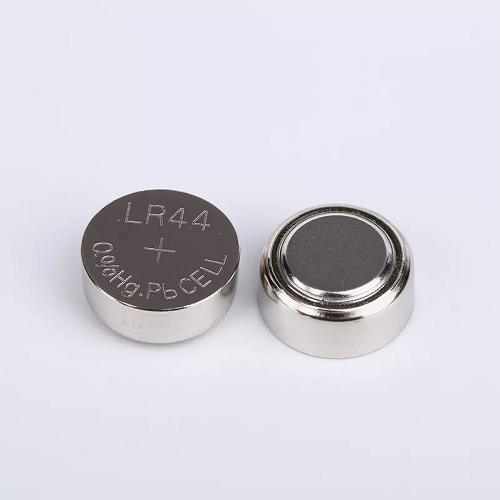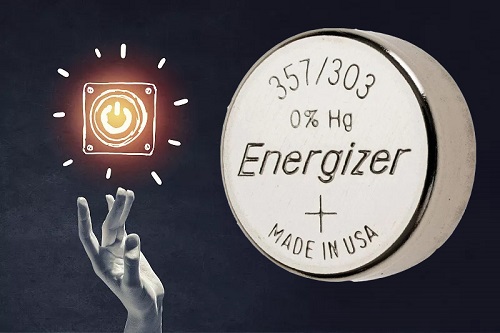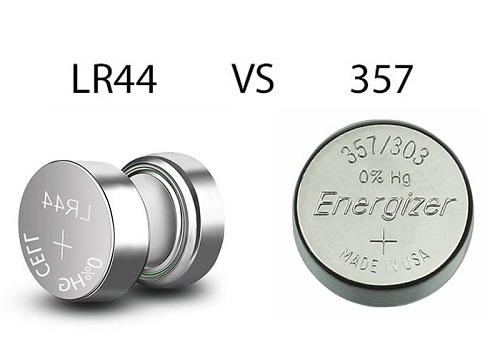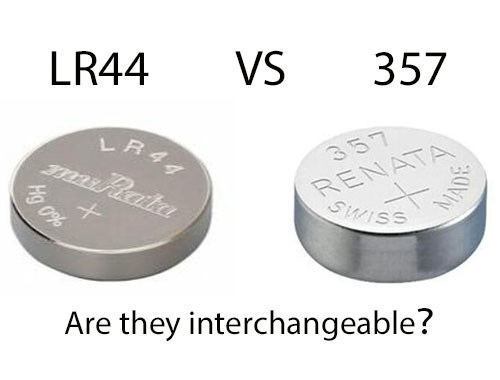LR44 vs. 357 guide: are they interchangeable?
Button batteries serve as a part of everyday life and high-end technological applications. This article provides a comprehensive and detailed comparative analysis of two widely used battery types - LR44 alkaline batteries and 357 silver oxide batteries.Although LR44 and 357 batteries appear to have the same shape, they perform differently.LR44 is an alkaline zinc-manganese button cell, while 357 is a silver oxide button cell. We will analyze the strengths, limitations, and applicability of these two types of batteries in a variety of devices, from chemistry to practical applications.
1. LR44 Battery: Detailed Analysis
2. Energizer 357 Battery: Detailed Analysis
3. LR44 vs 357 Battery: Advantages
4. LR44 vs 357: Similarities
5. LR44 vs 357 Battery Comparison
6. Interchangeability Issue: LR44 vs 357 Battery
7. LR44 vs 357 Battery: Disadvantages
8. Conclusion
1. LR44 Battery: Detailed Analysis

LR44 batteries are common zinc-manganese alkaline button cell batteries and their most significant advantages are good cost-effectiveness and stable discharge performance. Typically, the voltage of LR44 batteries is stabilized at 1.5 volts and the operating temperature range is from 0 to 60 degrees Celsius, with 20 degrees Celsius being the ideal range. It consists mainly of zinc and manganese dioxide with an alkaline electrolyte such as potassium hydroxide or sodium hydroxide. The zinc and manganese dioxide act as the positive and negative electrodes, while the alkaline electrolyte provides a stable discharge profile and ensures reliability over a wide range of temperatures.
2. Energizer 357 Battery: Detailed Analysis

The Energizer 357 battery is a versatile silver oxide battery. The 357 battery has a slightly higher voltage of 1.55 volts compared to standard 1.5 volt alkaline batteries. The chemistry consists of silver oxide (Ag2O) as the positive electrode, zinc (Zn) as the negative electrode, and an alkaline electrolyte. They are typically used to power high-energy devices such as precision medical equipment and quartz watches.
3. LR44 vs 357 Battery: Advantages
Advantages of LR44 Battery

Benefits of LR44 Batteries
LR44 batteries are versatile and can provide 50 to 200 hours of continuous power for many applications. However, their flat shape can sometimes make it difficult to distinguish between positive and negative terminals. Typically the positive terminal is located on the flat side, while the small rounded protrusions are located on the opposite side of the negative terminal.
Another significant advantage of LR44 batteries is that they do not contain toxic elements such as mercury or cadmium. This not only makes it environmentally friendly, but also simplifies the disposal process. Its lightweight nature also further solidifies its position as the preferred choice for weight-conscious applications.
Advantages of 357 Battery

Benefits of 357 Batteries
LONGER LIFE: The Energizer 357 battery boasts a capacity of approximately 150mAh and a higher energy density to ensure power for longer periods of time, delaying the need for replacement.
Reliability: The battery is manufactured according to strict standards and can provide stable output voltage, which is an important support for the smooth operation of electronic devices.
Great compatibility: 357 batteries are widely used in many small electronic devices and are available in a variety of models, highlighting the versatility of the Energizer 357 battery.
Compact form factor: This battery is small and lightweight, and its design is perfect for storage and transportation, making it ideal for portable electronics.
Alkaline Composition: Unlike alkaline chemistries, the Energizer 357 outperforms others in terms of shelf life and performance.
4. LR44 vs 357: Similarities

Size Comparison
The LR44 and 357 batteries share identical external dimensions, measuring at 5.4mm x 11.6mm.
Voltage and Size Compatibility
Despite some variances, their similar voltage levels and sizes often make them interchangeable in certain devices. This interchangeability, however, depends on the device's specifications.
Manufacturer Naming Conventions
A point of confusion for consumers arises from manufacturers' practice of assigning various names to the same battery. Names like LR1154, AG13, LR44, 357, and A76 are used interchangeably, which can lead to uncertainty when purchasing.
Device Compatibility and Performance
In devices designated for LR44/A76 batteries, opting for a 357 battery could potentially extend the device's lifespan, thanks to its higher capacity. This benefit, however, hinges on the specific requirements of the device in question.
5. LR44 vs 357 Battery Comparison

Let's chat about those little powerhouses you pop into your gadgets: LR44 and 357 batteries. You might also hear them called SR44 or SR44W. They're like the unsung heroes of the electronic world, powering up all sorts of devices. But, even though they look similar, they've got their own special features. Let's break it down into simpler terms:
Size and Where They Fit:
LR44 Battery: This little guy is about 11.6mm across and 5.4mm thick. It's the go-to battery for anything that says it needs an LR44, AG13, or A76.
357 Battery: It's basically the same size as the LR44. Also 11.6mm in diameter and 5.4mm tall. It's perfect for gadgets that ask for a 357, SR44, or SR44W battery.
What's Inside That Counts:
LR44 Battery: Inside, it's a mix of manganese dioxide and zinc getting cozy to create electricity. Manganese dioxide acts like the cathode and zinc the anode.
357 Battery: This one's got silver oxide and zinc inside. Silver oxide steps up as the cathode with zinc as the anode, and together, they generate power.
Power Talk:
LR44 Battery: It's usually an alkaline battery, giving you 1.5 volts of power.
357 Battery: Also delivers 1.5 volts but comes as a silver oxide battery. This means it keeps a steady power flow longer than its alkaline buddy.
How Much They Can Handle:
LR44 Battery: It can hold a charge of about 100-150 milliamp-hours (mAh).

357 Battery: Packs a bit more punch, with a capacity of 150-200 mAh, thanks to that silver oxide.
Where They Shine:
LR44 Battery: Great for gadgets that don't eat up too much power like calculators, small lights, remote controls, toys, and some games.
357 Battery: Also loves low-drain devices but is a favorite for things that need reliable power, like precision instruments.
Getting Your Hands on Them:
LR44 Battery: You can find these easily and they won't break the bank. Check out stores or look online.
357 Battery: Might not see them as much in stores, but they're a click away online. They might cost a bit more because of that silver oxide.
So, although LR44 and 357 batteries might seem interchangeable at a glance, they each have their own best uses based on what your device needs and how it uses power. Always good to check what your device recommends before making a choice.
6. Interchangeability Issue: LR44 vs 357 Battery

Understanding the interchangeability of LR44 and 357 batteries demands a grasp of their distinct chemical compositions and voltage output characteristics. The LR44, a standard 1.5-volt alkaline button cell, comprises zinc and manganese dioxide. This combination results in a gradual voltage decline during usage, tolerable for devices not dependent on highly stable voltage.
Conversely, the 357 battery, a 1.55-volt silver oxide button cell, contains mainly silver oxide and zinc. This formula yields a higher energy density and voltage stability, enabling the battery to maintain consistent voltage throughout its discharge cycle. It's especially apt for precision devices, such as upscale watches and certain medical equipment, which are sensitive to voltage fluctuations.
Despite their similar size allowing physical interchangeability in some devices, the LR44 and 357 batteries differ significantly in performance and suitable applications. For basic electronic devices like remote controls or small toys, where stable voltage is not crucial, LR44 batteries are generally adequate. In contrast, for precision devices demanding stable voltage and long-term reliability, the 357 battery is the superior option.
Thus, battery selection hinges on the device's specific needs. If the device is prone to voltage sensitivity or requires a stable, long-lasting energy supply, opting for a 357 battery is the prudent choice. However, for devices less affected by voltage fluctuations, the LR44 battery presents a more economical alternative.
7. LR44 vs 357 Battery: Disadvantages
Disadvantages of LR44
The LR44, while useful, comes with several drawbacks:
- - Non-rechargeable: This battery type is disposable; once depleted, it cannot be recharged.
- - Limited Capacity: Despite its high energy density, the LR44 falls short in capacity when compared to other battery types.
- - Reduced Voltage: Its operating voltage is 1.5V, marginally lower than the 357's 1.55V.
- - Higher Cost: Compared to other alternatives like zinc-carbon and silver oxide batteries, the LR44 is less budget-friendly.
Disadvantages of 357
The 357 battery, though advantageous in many aspects, also has its shortcomings:
- - Non-rechargeable: Similar to the LR44, the 357 battery is also non-rechargeable.
- - Capacity Declines Over Time: The 357 experiences a gradual decrease in capacity with prolonged use.
- - Heat Sensitivity: This battery is more vulnerable to heat compared to alkaline batteries like the LR44.
- - Higher Cost: In terms of cost-effectiveness, the 357 doesn't fare as well as some alternatives, including zinc-carbon and silver oxide batteries.
8. Conclusion
In retrospect, although the voltage stability and life of LR44 batteries are slightly inferior to silver oxide batteries, they are still the first choice for many small electronic devices due to their cost-effectiveness and wide applicability.AndAnd 357 silver oxide battery with its excellent energy density, stable voltage output, low self-discharge rateAnd 357 silver oxide batteries with its excellent energy density, stable voltage output, low self-discharge rate moreAnd 357 silver oxide batteries with its excellent energy density, stable voltage output, low self-discharge rate is more adaptable to theAnd 357 silver oxide batteries with its excellent energy density, stable voltage output, low self-discharge rate is more suitable for high-precision equipment in theAnd 357 silver oxide batteries with its excellent energy density, stable voltage output, low self-discharge rate is more adaptable to high-precision equipment
Therefore, when considering battery selection, we should weigh the performance advantages and cost-effectiveness of these two types of batteries according to the specific requirements of the equipment and budget constraints to make a wise choice. This is the whole content of this article, if you have questions, you can contact us!
FAQ
1. Does the LR44 battery have a larger capacity than the 357 battery?
Answer: No, the power of the LR44 is less than that of the 357. The LR44 is a low-power battery, and its lifespan is not as long as that of the 357.
2. What are the best features of the 357?
Answer: Compared to most batteries, 357 batteries are characterized by more stable voltage capability, longer life (5 years), and a larger charge (150mAh).
3. Are they interchangeable?
Answer: LR44 and 357 batteries are interchangeable in size and other characteristics, but they have different voltages and chemistries. They are not recommended to be used as replacements for each other in the case of equipment with high constant voltage requirements.
4. What batteries can I use to replace the LR44?
Answer: Replacement options for the LR44 include the Maxell 76A, Energizer A76, and AG13 batteries.
5. How can I physically distinguish between LR44 and 357 batteries?
Answer: By looking at them we can see that both usually exhibit similar physical characteristics. Both are button cells, cylindrical in shape, and both have a diameter of 11.6 millimeters. However, the LR44 will be slightly shorter than the 357 - the LR44 battery measures 28.5 millimeters, while the 357 is 30.0 millimeters.